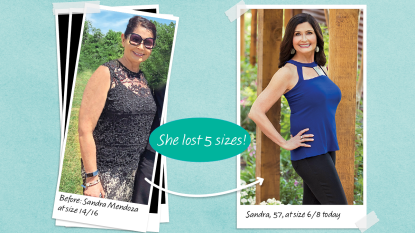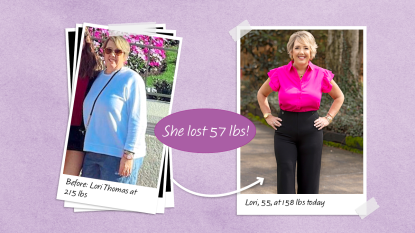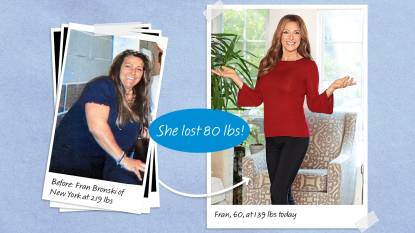Chronic Inflammation Triggers Go Beyond the Physical — Here’s How To Control What You Can, According to Doctors
You have more power than you think.

You know that eating burgers and fries all the time, staying up late, and being a couch potato can set you up for health problems. The damage goes far beyond what you see happening on the outside of your body, however. The real trouble is happening deep inside. It’s called chronic inflammation. And all the things that help reduce your risk of heart disease, diabetes, and other chronic health conditions will also help stem it. But there are some surprising culprits that might be evading your otherwise healthy habits.
Inflammation 101
There are two types of inflammation: Acute and chronic. Acute inflammation is the one you’re probably more familiar with, as it shows up after you skin your knee or burn your hand, for instance. The response from your body is immediate, lasts only a short time, is localized to a specific body part, and helps the body heal, says Vanita Rahman, MD, clinic director of the Barnard Medical Center in Washington, D.C., and author of Simply Plant Based.
Chronic inflammation, on the other hand, happens over time, taking years to develop, with one “trigger” adding to the next, like building a bonfire. Unlike acute inflammation, chronic harms the body. “It’s been associated with health conditions like insulin resistance, diabetes, high blood pressure, sleep apnea, heart disease, Alzheimer’s, and many more,” Rahman says.
Although blood tests are the best way to check for markers of chronic inflammation, your body will start throwing off warning signs earlier, almost like an engine light in your car. “The inflammation starts with symptoms, which if you don’t listen to, can progress to illness and disease,” says Jyothi Rao, MD, medical director of the Shakthi Health and Wellness Center in Mount Airy and Elkridge, Maryland, and co-author of Body on Fire. Feeling chronically fatigued and gaining weight, especially around the midsection, are warning signs.
While genetics do play a role, your lifestyle habits make a bigger difference. “Between the two, lifestyle choices more commonly create inflammation that can lead to disease in any organ,” Rao says. Below are some surprising things that may be triggering inflammation.
Noise Pollution
Why It Drives Inflammation: It’s been associated with negative health outcomes in many studies because it contributes to mental stress, which can, among other things, affect the lining in blood vessels and increase your risk of heart disease. Plus, high cortisol from stress can keep your body in a constant fight-or-flight mode, which eventually leads to inflammation, Rao says. And don’t forget that you probably won’t be sleeping as well around noise, and sans sleep, your insides suffer.
How To Put Out the Fire: If you live around a lot of noise, it may be impossible to move. But you can at least take steps to create as much serenity in your life as possible. Think first about designing a quieter environment. Use a noise-canceling headset at work and at home, turn off TVs, electronic games, and the radio when you’re not using them. Then plan for quiet times so that you can at least give your mind a break from noise, Rao says. When you’re driving, avoid talking on the phone or listening to the radio. Consider planting greenery around your house, which can help absorb noise, she adds.
A Pessimistic Outlook
Why It Drives Inflammation: “Our brain chemistry affects our body chemistry, and literature suggests that if you’re more optimistic, you have a healthier, longer life,” says Rao, who was so miserable several years ago that even though she was doing everything else right, she was inflamed inside.
How To Put Out the Fire: You have more control over that mindset than you might think, so work to actively change it. Rao recommends doing things like starting a gratitude journal, meditating, practicing empathy for others, performing a random act of kindness, turning off the news, and checking social media less often.
Emphasizing Quantity Over Quality Sleep
Why It Drives Inflammation: As you sleep, your body flushes out toxins that build up during the day. You already know that you need to log a certain amount of z’s, but what often gets forgotten is quality of sleep. Are you waking frequently, tossing and turning, or not getting into that replenishing state of deep sleep? If you don’t feel refreshed when the alarm goes off, you might be dealing with low-quality sleep, which means your body won’t have a chance to detox, Rao says. The result? You’ll wake up with higher blood pressure, glucose, and cortisol levels, which can all drive inflammation, she says.
How To Put Out the Fire: Things like alcohol and caffeine can affect slumber quality. In addition, keeping the room too warm — or too dirty, since dust can promote allergies — will also keep you from resting soundly. If you’re following all of the sleep hygiene tips but your day-to-day functions are still suffering, talk with your doctor about hormonal imbalances, which can be a major slumber disruptor, Rao says. You may have too much cortisol coursing through your body at night or an imbalance of estrogen and progesterone, which happens during perimenopause.
Not Letting Your Gut Rest
Why It Drives Inflammation: What you eat is important but when you eat may matter just as much, if not more. “We were designed to eat and go to bed with the sunrise and sunset, and anything outside of that can be taxing on your immune system,” Rao says. Studies have shown numerous benefits from fasting, including decreased body weight, total cholesterol, and glucose. Plus, when you fast, you reduce inflammation in your body, she says. Skipping some meals may even increase the diversity of bacteria in your gut, which can offer protection against numerous diseases.
How To Put Out the Fire: Fast for 12 to 14 hours, or 10 hours at the very least, every night. For instance, if you’re doing a 12-hour fast and eat your last bite at 7 p.m., you wouldn’t eat again until 7 a.m., although you can have black coffee, herbal tea ,and water during that time. When Rao’s patients do this, they experience significant improvements in their lipid numbers and insulin resistance. The bonus? You might sleep better as a result, which can also lessen inflammation.
Sitting Too Much
Why It Drives Inflammation: Regular exercise is one of the best things you can do for your health, but it’s not only about structured exercise. You also have to pay attention to how much sedentary time you accumulate every day. Sitting, especially excessive amounts (more than four hours a day) has been called the “new smoking.” While the level of risk is still up for debate, “sitting is hugely inflammatory,” Rao says. After all, being sedentary can increase your risk of heart disease and depression, make your blood pressure rise, expand your waistline, and boost glucose and insulin, both of which are precursors to diabetes — and all of which contribute to inflammation. (Even people who get the recommended amount of exercise yet sit too much are at risk, according to a 2016 research review published in Annals of Internal Medicine.)
How To Put Out the Fire: Take a movement break at least every two hours over an eight-hour period so that you’re logging a minimum of three of these breaks a day, Rao says. (The same study above noted that longer bouts of sedentary time were more harmful than shorter bouts.) Take a quick walk, do a minute or two of forward folds and downward dogs, or squat 10 times. Of course, don’t sacrifice your regular workouts since those can help squelch inflammation (unless you overdo it), Rahman says. She recommends working up a solid sweat five or six days a week if you can, doing a mix of aerobic exercise, strength training, and flexibility and balance training.
Feeling Isolated
Why It Drives Inflammation: Humans are by nature social creatures, and a lack of connection with other people can be devastating to our health. “Although we don’t know the exact mechanisms, there is a correlation between social isolation and inflammation,” Rahman says. On the flip side, data from the Blue Zones, those areas of the world where people not only live the longest but are also the healthiest, emphasize how social connections extend lives.
How To Put Out the Fire: It’s a no-brainer that the more you can connect with others, the better. And while there are numerous ways to do that — volunteer for a cause you’re passionate about so that you meet like-minded souls, join a group focused on a mutual interest, take classes, start a book group, or get more involved in your church or temple — you can also take a page from people in Okinawa, Japan, one of the world’s Blue Zones. They have a concept called a moai, a circle of friends who support them throughout life. Think about the people who lift you up and ask them to join your own moai. Then schedule regular get-togethers, in person or virtual.
The Chicken or the Egg?
It’s clear that inflammation ties into many of the chronic health conditions that plague Americans, including heart disease and diabetes. But here’s the question: Is the inflammation causing the condition (or exacerbating it), or did the condition trigger an onslaught of inflammation? The answer isn’t clear-cut since it’s hard to parse the two in research studies. “We don’t know which is causing which, but regardless, we have to be mindful of all of the lifestyle habits that can impact inflammation,” says Vanita Rahman, MD. And they make a difference no matter if it was a cause or effect.
While any of the strategies here can be a good starting point, changing your diet may have the most impact. “Food plays such a big role in inflammation that it makes sense to start by transitioning to a plant-based diet,” she says. Numerous organizations like the Physicians Committee for Responsible Medicine, Forks Over Knives, and Veganuary offer free kick-starters and challenges to help you make the switch.
A version of this article appeared in our partner magazine, The Complete Guide to Anti-Inflammation, in 2023.













